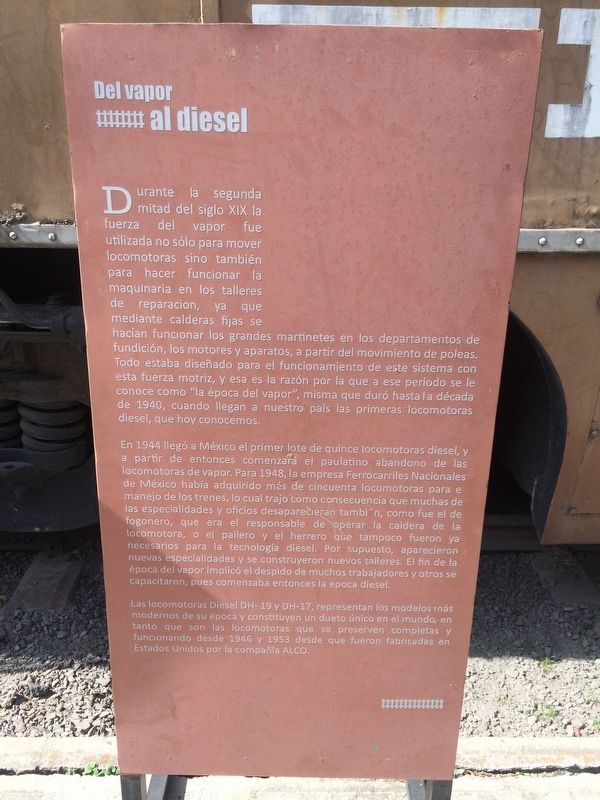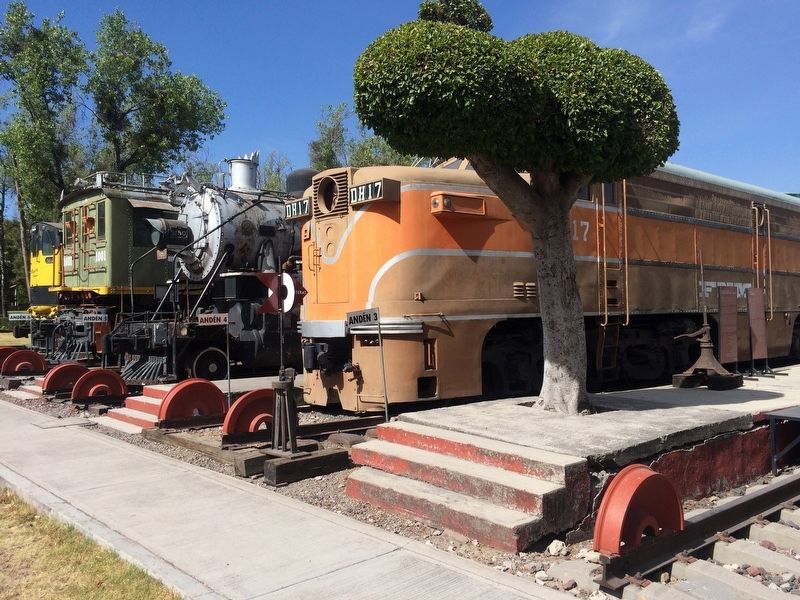Puebla, Mexico — The Central Highlands (North America)
From Steam to Diesel
Del vapor al diésel
Durante la segunda mitad del siglo XIX la fuerza del vapor fue utilizada no sólo para mover locomotoras sino también para hacer funcionar la maquinaria en los talleres de reparacion, ya que mediante calderas fijas se hacían funcionar los grandes martinetes en los departamentos de fundición, los motores y aparatos, a partir del movimiento de poleas. Todo estaba diseñado para el funcionamiento de este sistema con esta fuerza motriz, y esa es la razón por la que a ese periodo se le conoce como "la época del vapor", misma que duró hasta la década de 1940, cuando llegan a nuestro país las primeras locomotoras diesel, que hoy conocemos.
En 1944 llegó a México el primer lote de quince locomotoras diesel, y a partir de entonces comenzará el paulatino abandono de las locomotoras de vapor. Para 1948, la empresa Ferrocarriles Nacionales de México había adquirido más de cincuenta locomotoras para el manejo de los trenes, lo cual trajo como consecuencia que muchas de las especialidades y oficios desaparecieran también, como fue el de fogonero, que era el responsable de operar la caldera de la locomotora, o el pailero y el herrero que tampoco fueron ya necesarios para la tecnología diesel. Por supuesto, aparecieron nuevas especialidades y se construyeron nuevos talleres. El fin de la época del vapor implicó el despido de muchos trabajadores y otros se capacitaron, pues comenzaba entonces la epoca diésel.
Las locomotoras Diesel DH-19 y DH-17, representan los modelo más modernos de su época y constituyen un dueto único en el mundo, en tanto que son las locomotoras que se preserven completas y funcionando desde 1946 y 1953 desde que fueron fabricadas en Estados Unidos por la compañía ALCO.
English translation:
From Steam to Diesel
During the second half of the 19th century steam power was used not only to move locomotives but also to operate machinery in repair workshops, since by means of fixed boilers the large pile drivers were operated in the foundries and other engines and machines were also powered by belts. Everything was designed for operation in a system with this motive power, and that is the reason why that period is known as "the Steam Age", which lasted until the 1940s, when the first diesel locomotives arrived in our country.
In 1944 the first batch of fifteen diesel locomotives arrived in Mexico, and from then on the gradual abandonment of steam locomotives began. By 1948, the Mexican National Railroads Company (Ferrocarriles Nacionales de México) had acquired more than fifty locomotives for the handling of trains, which resulted in the disappearance of many of the specialties and trades associated with steam power, such
as the stoker, which was responsible for operating the boiler of the locomotive. The “pailero” and the blacksmith also were not needed for diesel technology either. Of course, new specialties appeared and new workshops were built. The end of the steam era implied the dismissal of many workers and the retraining of others since the beginning of the diesel era.
Diesel locomotives DH-19 and DH-17 represent the most modern engines of their time and make up a unique pair in the world, as they are two locomotives that are preserved intact and in working order since 1946 and 1953, when they were manufactured in the United States by the ALCO company.
Topics. This historical marker is listed in these topic lists: Industry & Commerce • Railroads & Streetcars. A significant historical year for this entry is 1940.
Location. 19° 3.183′ N, 98° 12.26′ W. Marker is in Puebla. Marker can be reached from Calle 11 Norte close to Avenida 14 Poniente, on the right when traveling south. The marker is on the grounds of the Mexican National Railroad Museum, to the south of the second row of engines and cars after the entrance. Touch for map. Marker is in this post office area: Puebla 72090, Mexico. Touch for directions.
Other nearby markers. At least 8 other markers are within walking distance of this marker. Diesel-Electric Locomotives DH-19 and DH-17 (here, next to this marker); Electric Locomotive FCM 1001 (a few steps from this marker); Mail Car NM 2555 (a few steps from this marker); Nationalization of the Railroads of Mexico - 1937 (within shouting distance of this marker); A National Railroad Network (within shouting distance of this marker); Engine 601 (within shouting distance of this marker); Steam Locomotive NM-601 (within shouting distance of this marker); The Hero of Nacozari (within shouting distance of this marker). Touch for a list and map of all markers in Puebla.
Credits. This page was last revised on December 14, 2017. It was originally submitted on December 14, 2017, by J. Makali Bruton of Accra, Ghana. This page has been viewed 148 times since then and 6 times this year. Photos: 1, 2. submitted on December 14, 2017, by J. Makali Bruton of Accra, Ghana.

